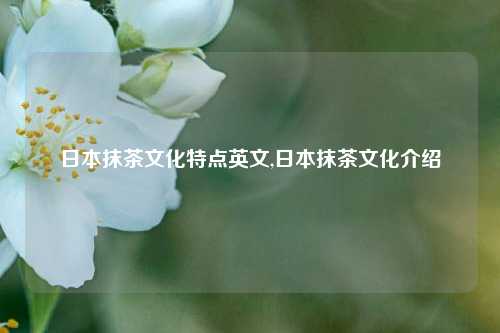日本抹茶文化特点英文,日本抹茶文化介绍
嘿,如果你正在寻找日本抹茶文化特点英文,那你来对地方了!日本抹茶文化特点英文绝对能给你惊喜。
日本抹茶文化英文介绍Introduction to Matcha Tea Culture in JapanThe Japanese culture is rich in tradition and artistry, and one of its most unique and fascinating aspects is the matcha tea culture. This article will explore the characteristics of the Japanese matcha tea culture, including its history, rituals, tea ceremonies, and tea-related art forms.History and OriginsMatcha tea originated in China, but it was adopted and adapted by the Japanese, who developed their own unique style of preparing and enjoying tea. The Japanese matcha tea culture has a long history, dating back to the Heian period (794-1185). It was during this time that tea became a central part of Japanese culture, with tea ceremonies becoming a way of life for many Japanese.Rituals and CeremoniesThe Japanese matcha tea ceremony is a highly ritualized and disciplined art form. It involves preparing matcha tea in a specific way, using traditional utensils and techniques. The tea ceremony is not just about drinking tea; it's about creating a harmonious atmosphere, expressing respect for the host and guests, and practicing mindfulness. These ceremonies are usually held in private residences or temples, and they can last for several hours.Tea-Related Art FormsThe Japanese matcha tea culture is also reflected in various art forms, including flower arrangement, calligraphy, and poetry. These arts are often used to complement the tea ceremony, creating a sense of harmony and beauty. In addition, there are also many artists who create beautiful tea sets and other accessories for the tea ceremony. These artisans use traditional techniques and materials to create unique and exquisite works of art.Flavor and Aroma of Matcha TeaMatcha tea is prepared by grinding green tea leaves into a fine powder and steeping them in hot water. The resulting tea has a rich, earthy flavor and a distinct aroma that is unique to matcha. It is often enjoyed with sugar or sweeteners such as honey, which adds a touch of sweetness to balance the bitter and astringent flavors.Technology and ProductionMatcha tea is produced using a special technique called "hulling." This process involves grinding the tea leaves into a fine powder while still attached to their hulls. This allows for a higher concentration of nutrients and flavor in the tea, while also preserving its green color. Matcha tea is also produced using high-tech equipment such as robotic harvesting machines and automated grinding machines, which have greatly improved production efficiency and quality control.ConclusionThe Japanese matcha tea culture is an integral part of Japanese culture, with its rich history, rituals, artistry, and unique flavor and aroma. It has been passed down through generations and is still practiced today by many Japanese people as a way of relaxing, connecting with nature, and practicing mindfulness. With its emphasis on quality and tradition, matcha tea has also become popular with foreigners who appreciate its unique flavor and artistry.。

如果你对日本抹茶文化特点英文还有任何疑问,或者想了解更多信息,随时欢迎联系我们。我们随时为你提供帮助和支持。









